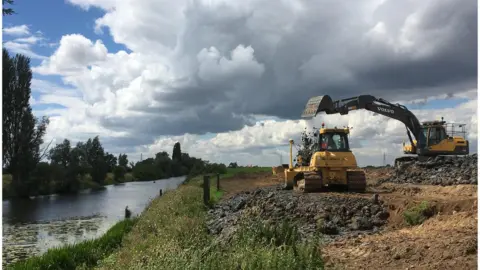Welney Ouse Washes reservoir flood defence work enters third phase
 Environment Agency
Environment AgencyThe latest phase of a four-year plan to raise the banks of a 22-mile (33km) flood reservoir will begin within weeks.
The Environment Agency is leading a £27m project to strengthen and protect the man-made banks of the Ouse Washes reservoir in the Cambridgeshire fens.
The work, which began in 2017, is taking place over four summers to avoid disturbing breeding wildlife.
When full, the reservoir holds enough water to fill Wembley Stadium 22 times.
 WWT
WWT Environment Agency
Environment AgencyThe reservoir - stretching from Earith near St Ives in Cambridgeshire to Downham Market in Norfolk - was built in 1653 by the Dutch engineer Cornelius Vermuyden, during a programme to reclaim fenland from periodic flooding.
Every year it protects thousands of properties, roads and railways - as well as 67,000 hectares of farmland - on the surrounding lower-lying land from winter flood water.
However, an inspection in 2013 identified problems with the safety and stability of the Middle Level Barrier Bank - (where the Welney Wash road crosses the reservoir. )
 Environment Agency
Environment Agency"Our objective is to maintain the high level of flood protection we provide to communities living near the Ouse Washes," said an Environment Agency spokesman.
"Our recent assessment of the bank height shows flood water could overtop the bank at isolated locations in the equivalent of a 1% probability event."
 Environment Agency
Environment AgencyThe Environment Agency is raising the bank between Earith and the Welmore Lake Sluice.
The area, which is rich in wildlife including wintering swans, geese and ducks, has international conservation status and is peppered with wetland nature reserves.
As a result, the work has been taking place between mid-July and October to protect breeding species.
 Google
GoogleConstruction will start on phase three on 15 July.
 Environment Agency
Environment AgencyA "demountable barrier system" will be built at the flood-risk A1101 Welney Wash road in 2020. It can be used to limit the effect of rising waters and would be put up each time Norfolk County Council closes the road to traffic.